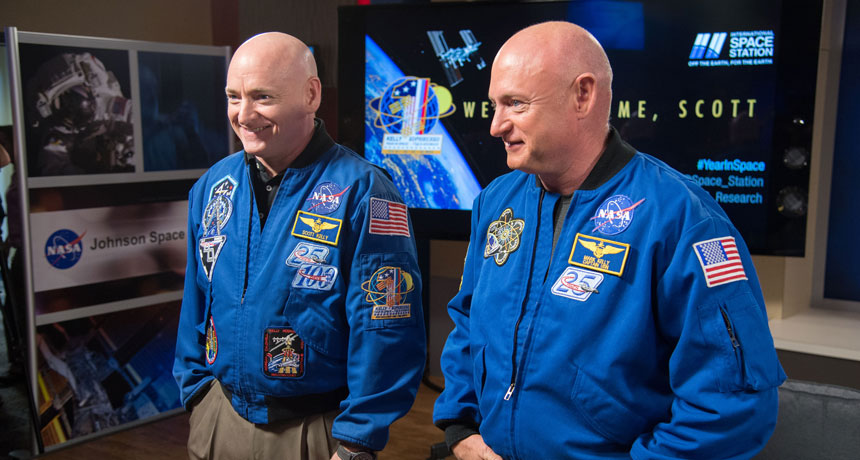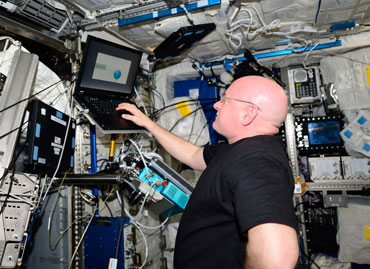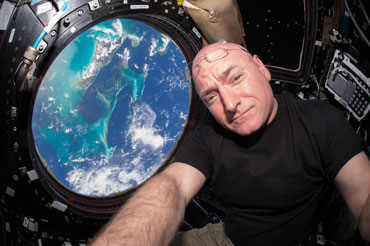How a year in space affected Scott Kelly’s health
A comparison to his twin looks at how long-term spaceflight changes the human body

Astronaut Scott Kelly (left) spent a year in space on the International Space Station while his identical twin brother, astronaut Mark Kelly (right), remained on Earth. They were part of a landmark study to help researchers understand how space flight affects the human body.
NASA
By Jeremy Rehm
For nearly a year, identical twins Scott and Mark Kelly lived in different worlds — literally. Mark enjoyed Earth-bound retirement in Tucson, Ariz. Meanwhile, Scott floated in microgravity aboard the International Space Station some 400 kilometers (250 miles) above the planet. That year apart has given scientists the clearest look yet at how long-term spaceflight can affect the human body.
Ten science teams in NASA’s Twins Study examined the brother astronauts before, during and after Scott’s 340 days in space. The teams studied each twin’s body functions. They ran memory tests. And they examined the men’s genes, looking what differences might be due to space travel.
The long-awaited results appeared April 12 in Science. They confirm that lengthy space travel stresses the human body in many ways. Space living can change genes and send the immune system into overdrive. It can dull mental reasoning and memory.
This is “the most comprehensive view that we’ve ever had of the response of the human body to spaceflight,” says Susan Bailey. She studies radiation and cancer at Colorado State University in Fort Collins. She also led one of the NASA research teams. She says it’s still unclear, however, whether the changes seen will cause long-term harm.
Genes in space
The scientists couldn’t go with Scott when he entered space in March 2015. So he had to help them out. While in orbit, he collected samples of his blood, urine and feces. Other visiting astronauts carried them back to Earth. Then, the research teams ran a host of different tests to analyze various body functions. They compared these data to those taken before and after Scott’s spaceflight.
Scott’s samples from space showed many genetic changes from those taken on Earth. More than 1,000 of his genes had chemical markers that weren’t in his preflight samples or in samples from Mark. These chemical markers are called epigenetic (Ep-ih-jeh-NET-ik) tags. They can be added or removed due to environmental factors. And they affect how genes work. A tag might affect their activity by determining if, when or how long a gene is turned on or off.
Some of Scott’s genes changed more than others. Those with the most epigenetic tags helped regulate DNA, Bailey’s team found. Some handle DNA repair. Others control the length of the tips of chromosomes, called telomeres.
Telomeres are thought to protect chromosomes. Shortened telomeres have been linked to aging and health risks, such as heart disease and cancer. The scientists had expected Scott’s telomeres might shorten in the low gravity and high radiation of space. So they were surprised to find that they actually had grown — 14.5 percent longer.
That growth didn’t last, however. Within 48 hours of his March 2016 return to Earth, Scott’s telomeres quickly shrank. Within several months, most of them were back to preflight lengths. But some telomeres had gotten even shorter. “That could be where he might be at increased risk” of cancer or other health problems, Bailey says.

Christopher Mason studies human genetics at Weill Cornell Medicine in New York City. His group looked at which genes were affected by spaceflight. In Scott’s early blood samples from space, Mason’s team noted many immune-system genes switched onto active mode. While a body is in space, “the immune system is on almost a high alert as a way to try and understand this new environment,” says Mason.
Scott’s chromosomes also went through many structural changes, another team found. Chromosome parts were swapped, flipped upside down or even merged. Such changes can lead to infertility or certain types of cancer.
Michael Snyder, who led another of the teams, was not surprised by such changes. “These are natural, essential stress responses,” he says. Snyder studies human genetics at Stanford University in California. His group looked for stress-caused shifts in the twins’ immune systems, metabolism and production of proteins. It’s likely that high-energy particles and cosmic rays in space worsened the changes in Scott’s chromosomes, Snyder says.
Lasting effects
Most changes that Scott experienced in space reversed once he returned to Earth. But not everything.
The researchers tested Scott again after six months back on land. Roughly 91 percent of the genes that had changed activity in space were now back to normal. The rest stayed in space mode. His immune system, for instance, remained on high alert. DNA-repair genes were still overly active and some of his chromosomes were still topsy-turvy. What’s more, Scott’s mental abilities had declined from preflight levels. He was slower and less accurate on short-term memory and logic tests.
It’s unclear whether these results are definitely from spaceflight. That’s partly because the observations are from only one person. “Bottom line: There’s a ton we don’t know,” Snyder says.

More answers may come from upcoming missions. Last October, NASA funded 25 new projects that each could send up to 10 astronauts on yearlong space missions. And on April 17, NASA announced an extended space visit for U.S. astronaut Christina Koch. She reached the International Space Station in March. This mission, until February 2020, will make her spaceflight the longest yet for a woman.
But to learn how space really impacts health may call for even longer trips. A mission to Mars and back would take an estimated 30 months. It would also send astronauts beyond Earth’s protective magnetic field. That field shields against DNA-damaging radiation from solar flares and cosmic rays.
Only astronauts on the lunar missions have gone beyond Earth’s magnetic field. None of those trips lasted more than a few days each. So no one has spent even one year in that unprotected environment, let alone 2.5 years.
Markus Löbrich works at the Technical University of Darmstadt in Germany. Although not part of the NASA Twins Study, he does research into radiation’s effects on the body. The new data are impressive, he says, but highlight that we are not yet ready for longer-term space travel.
One way to avoid such long space exposures would be to speed up the trip, he notes. Perhaps new ways of propelling rockets through space could reach distant places more quickly. But most of all, he says, sending people to Mars will require better ways to protect people against radiation in space.







